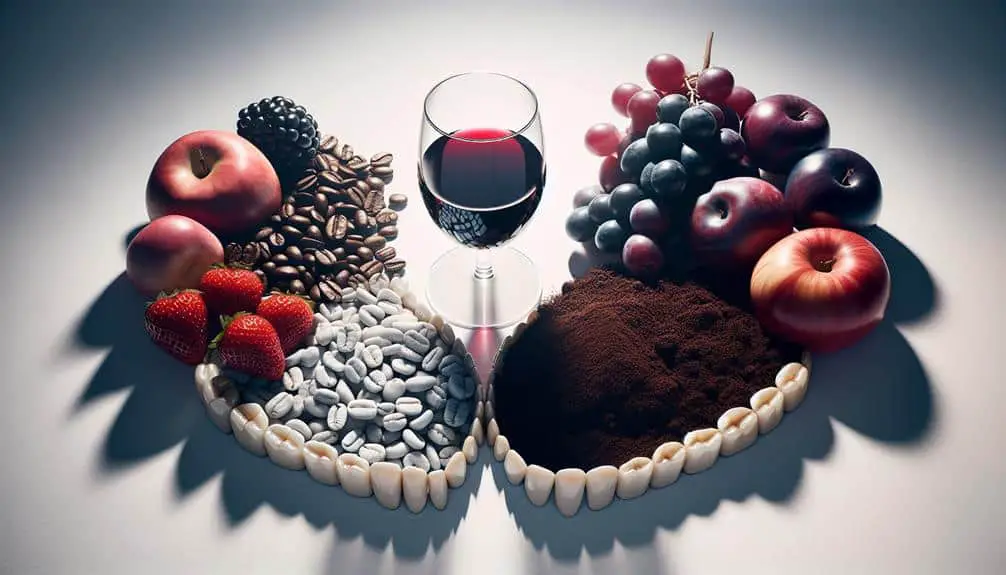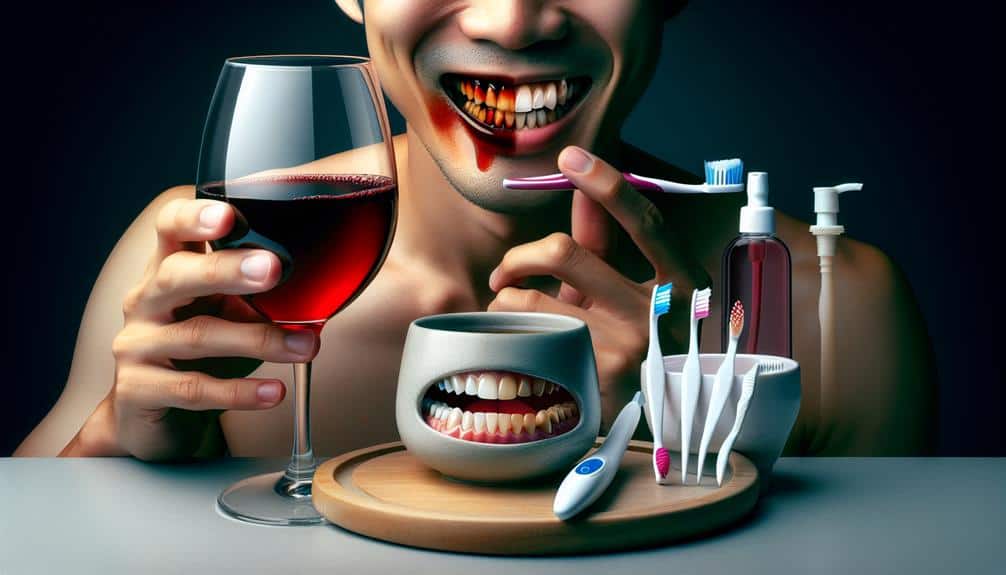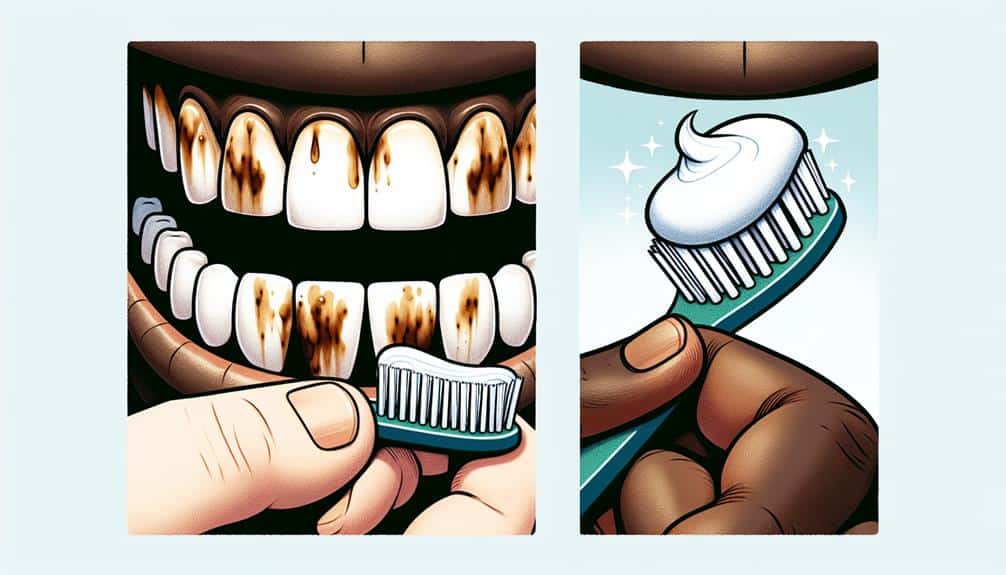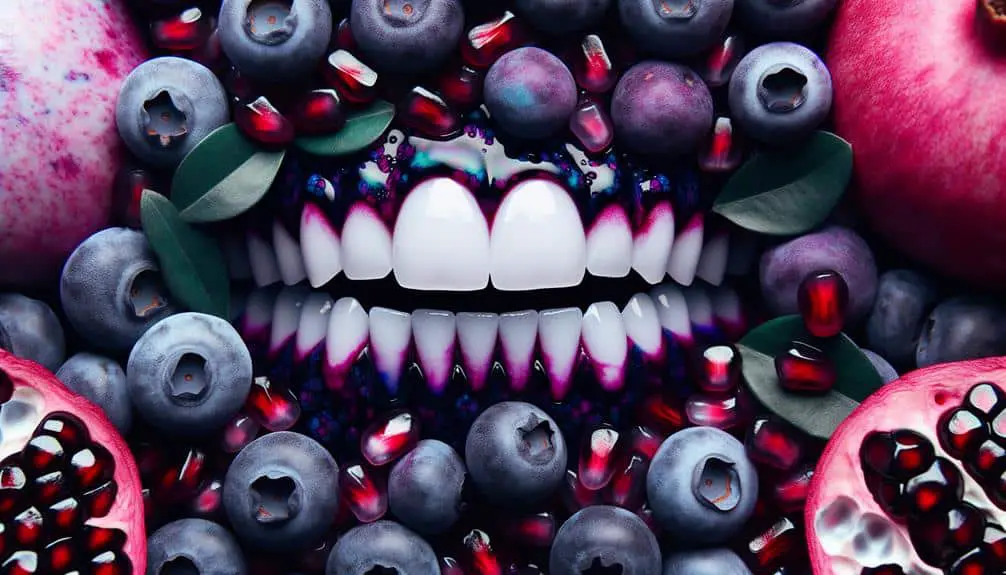If you want to avoid tobacco-related teeth staining, be cautious of consuming dark beverages like coffee and tea, which contain tannins and chromogens known to discolor enamel. Red wine's acidity and tannins can intensify yellowing caused by tobacco. Dark berries, with their vibrant pigments and acidity, are also offenders. Even spices like curry, rich in pigments from turmeric, can adhere to enamel. Understanding these food sources is essential for maintaining a bright smile.
Key Points
- Tobacco-related teeth staining can be intensified by foods with high acidity.
- Dark-colored foods like berries can compound staining from tobacco use.
- Foods with strong pigments, like curry, can exacerbate tobacco-related teeth discoloration.
- Tannin-rich foods such as red wine can worsen tobacco-induced teeth yellowing.
- Coffee and tea, common culprits of teeth staining, can also magnify the effects of tobacco on teeth.
Impact of Coffee on Teeth Staining
Coffee is a well-known culprit when it comes to causing teeth staining due to its high levels of tannins and chromogens. These compounds in coffee can lead to discoloration of the enamel, making teeth appear yellow or brown over time. Regular coffee consumption can also contribute to enamel erosion, which weakens the outer layer of the teeth and makes them more susceptible to staining.
To minimize the impact of coffee stains on your teeth, it's essential to practice good oral hygiene. Brushing your teeth after consuming coffee can help remove surface stains and prevent them from setting in. Additionally, using a straw to drink coffee can reduce direct contact with your teeth, lowering the risk of staining. Regular dental check-ups and professional cleanings can also aid in removing stubborn coffee stains and maintaining overall oral health.
Being mindful of your coffee consumption and implementing proper oral care habits can help prevent or reduce the effects of coffee on teeth staining. Remember, moderation and good oral hygiene are key to preserving a bright, white smile.
Teas Role in Tooth Discoloration
Tea, like coffee, can also play a significant role in causing tooth discoloration due to its high content of tannins and chromogens. Tannins are a type of polyphenol found in tea that can lead to staining by promoting the adhesion of chromogens to the enamel surface of teeth. Green tea, although touted for its health benefits, contains tannins that can contribute to discoloration. However, green tea also has properties that may help combat bacteria and reduce the risk of cavities, making it a better choice than other teas.
When it comes to herbal teas, their impact on tooth discoloration varies. Herbal teas can have less staining potential compared to black tea due to their lower tannin content. Some herbal teas, like chamomile or peppermint, may even have whitening properties. It's crucial to take into account the overall oral health benefits when selecting teas to consume. While tea can stain teeth, practicing good oral hygiene habits and regular dental cleanings can help minimize discoloration.
Red Wine and Teeth Yellowing
Red wine, known for its rich color and bold flavor, can contribute to teeth yellowing due to its high acidity and tannin content. When you indulge in red wine, you expose your teeth to substances that can lead to staining and discoloration over time. Here's why red wine can affect the brightness of your smile:
- Acidity: The high acidity in red wine can weaken the enamel, making it more susceptible to stains and discoloration.
- Tannins: Tannins, naturally found in red wine, can lead to teeth yellowing by promoting the adhesion of chromogens – compounds that cause discoloration.
- Enamel Erosion: Red wine's acidity can contribute to enamel erosion, further exposing the yellow-tinged dentin underneath.
- Synergy with Tobacco Staining: When combined with teeth staining from smoking tobacco, red wine can intensify the discoloration, making it essential to be mindful of these factors for maintaining a radiant smile.
Dark-Colored Berries and Stains
Dark-colored berries, such as blueberries and blackberries, can contribute to teeth staining due to their vibrant pigments and acidic nature. These berries contain intense pigments that can adhere to the enamel of your teeth, leading to discoloration over time. Additionally, the acidity in berries can weaken the enamel, making it more susceptible to staining from other foods and drinks.
When consuming dark-colored berries, it's advisable to rinse your mouth with water afterward to help reduce the pigments' effects on your teeth. Moreover, incorporating foods that can help neutralize acidity, such as crunchy fruits and vegetables, can aid in minimizing the potential staining caused by berries.
Interestingly, certain beverages like black tea have been associated with promoting dental health despite their dark color. Compounds found in black tea can help suppress the growth of bacteria in the mouth, reducing the risk of plaque formation and cavities. However, moderation and proper oral hygiene practices remain essential to mitigate any potential staining effects from dark-colored berries.
Currys Effect on Dental Whiteness
Curry's impact on dental whiteness can be influenced by its vibrant pigments and potential staining properties. When contemplating the effect of spicy foods like curry on dental whiteness, it's crucial to comprehend how certain ingredients can impact the color of your teeth.
Here are four key points to keep in mind:
- Turmeric Benefits: Turmeric is a common component in curry powders and pastes. While turmeric offers various health advantages, its intense yellow pigment can contribute to dental staining over time.
- Staining Properties: The vivid hues in curry, particularly from spices like turmeric, can adhere to the enamel of your teeth, leading to discoloration.
- Consumption Frequency: Regular intake of curry dishes can increase the likelihood of teeth staining, as the pigments have more opportunities to adhere to the teeth.
- Preventive Measures: To mitigate the effects of curry on dental whiteness, consider utilizing a straw when consuming curry dishes to minimize contact with your teeth, and maintain good oral hygiene practices like regular brushing and dental check-ups.
Frequently Asked Questions
Can Tobacco-Related Teeth Staining Be Reversed or Removed Completely?
You can reverse or remove tobacco-related teeth staining completely through professional teeth whitening treatments. These procedures are highly effective and can greatly improve the appearance of your teeth. Consider tobacco alternatives to prevent future staining.
How Does Tobacco Use Specifically Affect the Color of Teeth Compared to Other Foods and Drinks?
Tooth staining from tobacco is primarily due to nicotine and tar. These substances adhere to enamel, causing yellowing and discoloration. Unlike foods or drinks, tobacco accelerates enamel erosion, making tooth whitening challenging. Consult cosmetic dentistry for solutions.
Are There Any Natural Remedies or Treatments for Tobacco-Related Teeth Staining?
To combat tobacco-related teeth staining, consider herbal remedies like oil pulling. Whitening toothpaste can also help. DIY solutions have gained popularity. Remember, prevention is key, but these options can assist in brightening your smile naturally.
Is There a Correlation Between the Frequency of Tobacco Use and the Severity of Teeth Staining?
The severity of teeth staining from tobacco use can increase with the frequency of usage. The more often you use tobacco products, the more likely you are to experience significant discoloration and damage to your teeth.
Are There Any Preventive Measures Individuals Can Take to Minimize the Impact of Tobacco on Teeth Discoloration?
To minimize the impact of tobacco on teeth discoloration, you must be vigilant in your preventive measures. Your dietary habits play an important role; aim to consume stain-fighting foods and maintain excellent oral hygiene practices consistently.



